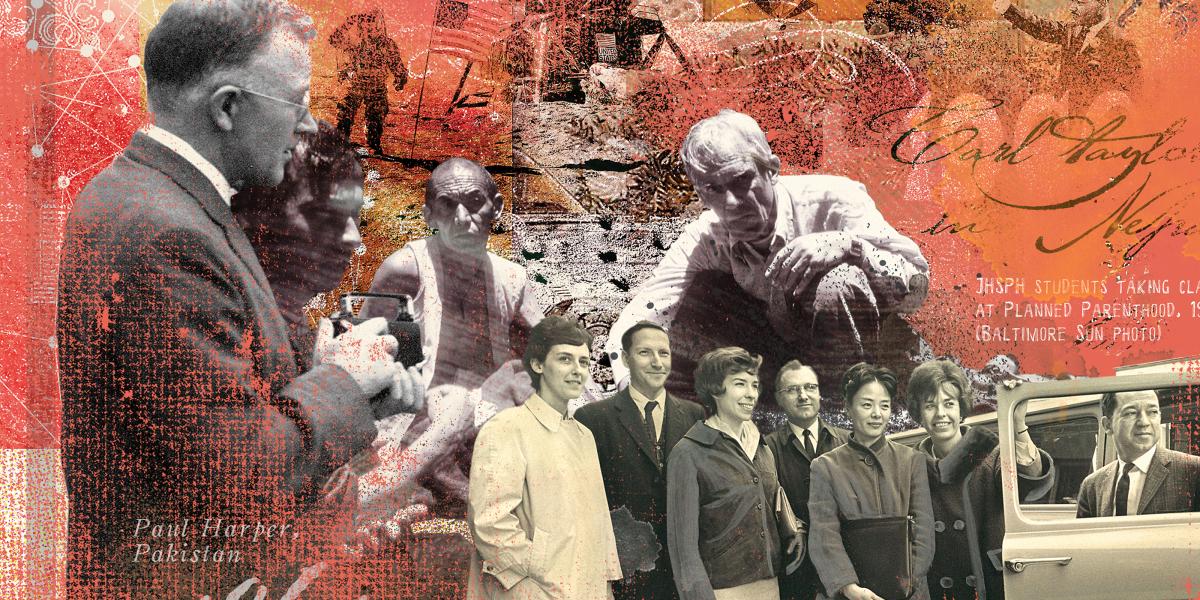Public Health and Foreign Policy
Turning Points | Four defining moments in the history of the Bloomberg School
The Cold War intensified the military’s relationship with schools of public health, and the U.S.-Soviet rivalry became a new justification for the public health mission, even in agencies and schools far removed from international health. Every aspect of JHSPH adapted to the new realities of a country constantly looking over its shoulder for potential threats, yet fervently hoping for peace.
In 1961, JHSPH received a grant from the newly established U.S. Agency for International Development to establish the Division of International Health, which served as the academic research and training base for USAID’s health section. To head the new division, JHSPH appointed Carl E. Taylor, who envisioned a holistic approach to public health that integrated reproductive health services into strengthened systems of primary care. Taylor used extensive randomized controlled field trials to evaluate multiple approaches to interrelated problems in nutrition, diarrheal diseases, maternal and child health and family planning in the Narangwal Studies in northern Punjab, India.
The same year, Paul Harper, MPH ’47, founded the West Pakistan Population Research and Evaluation Center (WEPREC) with funding from the Ford Foundation and Pakistan’s government. Harper chaired Maternal and Child Health, which became a department in 1962, and its new Division of Population Dynamics was the first in a series of administrative transitions that reflected the growing importance of population-level family planning as a major domestic and international health policy issue. The Ford Foundation, NIH and USAID awarded grants to found the division in 1965, after Harper organized the first academic conference ever held on population dynamics and international health for senior USAID staff and representatives from American universities, foundations and private agencies. The conference produced official guidelines for USAID population programs and the field’s first textbook.
The USAID population conference demonstrated that academics in public health, economics and demography were the greatest sources of influence on the decision of President Johnson and Congress to endorse population control as official U.S. policy in 1965. Johnson shifted the calculus of U.S. policy firmly toward restricting population growth when he reckoned that “less than five dollars invested in population control is worth a hundred dollars invested in economic growth.” Envir Adil, Pakistan’s family planning commissioner, worked with Harper to secure government approval for promoting the newly developed IUD, with a tenfold budget increase for family planning. By 1968, family planning ranked as the third largest employer in Pakistan, after railroads and the army.
One of the most important advocates of limiting world population growth was Phyllis Piotrow, PhD ’71, then legislative assistant to Senator George S. McGovern. In April 1965, Piotrow became the founding executive director of the Population Crisis Committee, which raised public and political support for population programs. She was one of Harper’s first doctoral students in Population Dynamics, and while still at JHSPH she worked closely with Reimert Ravenholt to write the first legislation to fund USAID population programs. Her dissertation, published in 1972 as World Population Crisis: The United States Response, was acclaimed as the definitive history of the development of U.S. government policies and programs on international population growth and family planning. Piotrow became a leading advocate for extending the birth control pill’s use in the developing world and joined the JHSPH Population Dynamics faculty in 1978 as the first director of the Population Information Program. In 1987, she established the Center for Communication Programs, which has since provided technical, financial, field and training assistance for more than 100 reproductive health communication and other health-related programs in developing countries.
-
1956
The hygiene part of the Doctor of Science in Hygiene degree is dropped.
-
1961
The Division of Mental Hygiene becomes a full department—the first in a school of public health.
-
1962
George Comstock founds the Johns Hopkins Training Center for Public Health Research.
-
1963
Pathobiology chair Frederik Bang develops the Lysate limulus test to detect bacterial endotoxins.
-
1964
Timothy D. Baker establishes the General Preventive Medicine Residency.
-
1965
Chronic Diseases chair Abraham M. Lilienfeld directs the Presidential Commission on Heart Disease, Cancer and Stroke.
-
1966
Epidemiology chair Philip Sartwell chairs FDA report on risks associated with oral contraceptives.
-
1967
John Hume, a leader in STD control, preventive medicine and international health, is named dean.
-
1968
Donald Cornely and Ruth Freeman establish a nurse-midwifery program that trains academic leaders.
THE ROAD TO ALMA ATA
In May 1974, the Indian government forced Carl Taylor to shut down the Narangwal Rural Health Research Center, the last USAID project left in India. Flying home to the United States, Taylor found himself seated next to Robert McNamara, president of the World Bank. Taylor urged McNamara to embrace Narangwal’s holistic approach to reproductive health and broaden loan programs to support “human capital” through health, nutrition, education and family planning. Taylor also helped organize the 1978 Alma Ata World Conference on Primary Health Care; public health leaders from around the world met in the Soviet Union to champion “community-based primary health care where health workers empower people to solve their own problems rather than promote dependency.” The Alma Ata Declaration remains a touchstone of the global health equity movement.
